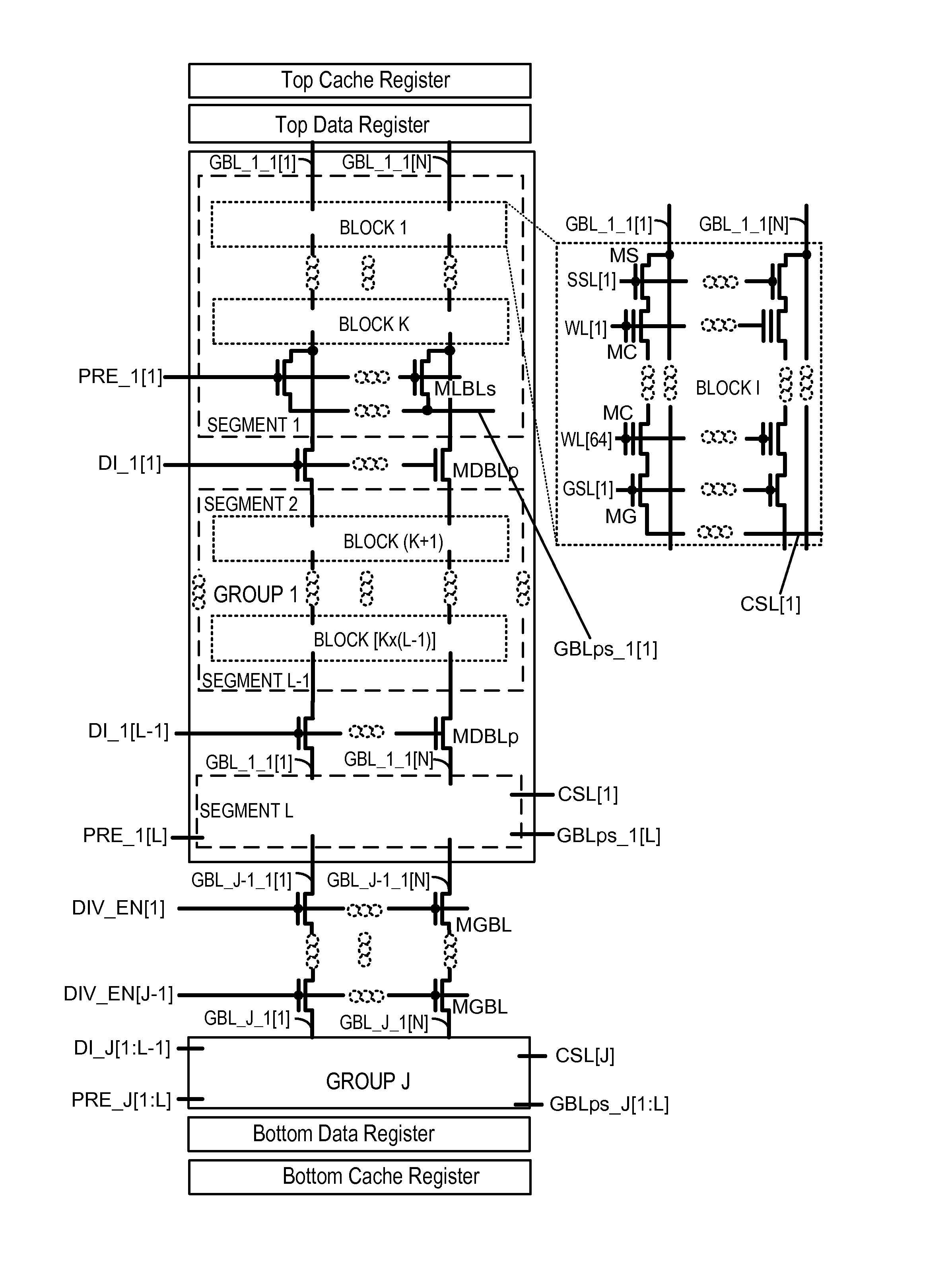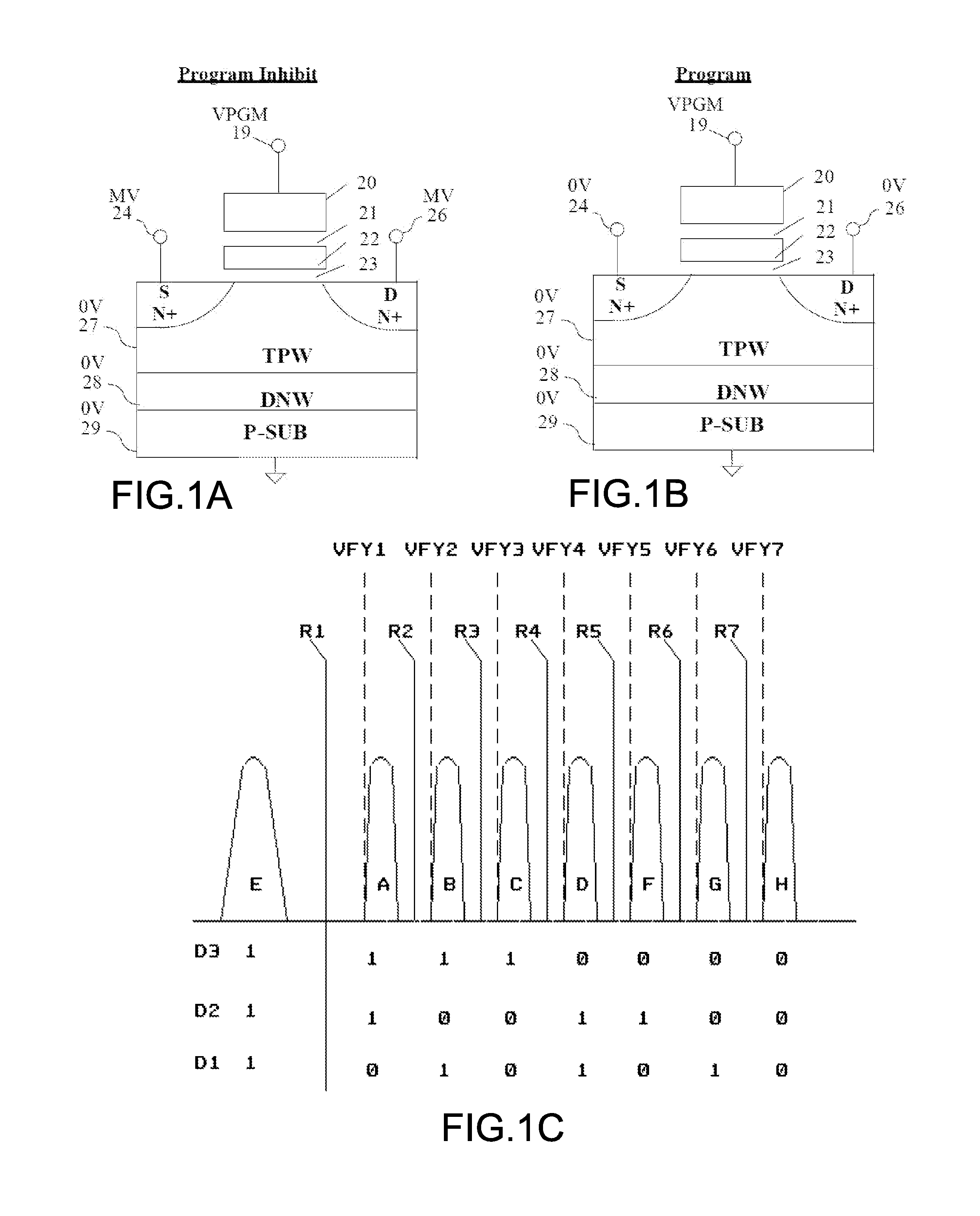NAND array hiarchical bl structures for multiple-wl and all-bl simultaneous erase, erase-verify, program, program-verify, and read operations
a nand array and bl structure technology, applied in static storage, digital storage, instruments, etc., can solve the problems of short data retention life cycle, low program, erase and read cycle, high power consumption, etc., and achieve the highest read speed, fast read speed, and large channel width
- Summary
- Abstract
- Description
- Claims
- Application Information
AI Technical Summary
Benefits of technology
Problems solved by technology
Method used
Image
Examples
case1
[0305] Each WL data of Vss-program and Vdd-inhibit voltages are coupled directly from a N-bit PB to one selected N-bit Block at a time. These Vss and Vdd voltages are passed to the selected channels through N selected broken GBLs, through N selected MLBLp transistors in on-state to N broken LBL lines and then to N Selected NAND Strings through N first String-select transistors MS in on-state and N second String-select transistor MG in off-state to prevent the String leakage. All this Vdd-inhibit and Vss programmed voltages are then latched or trapped in the selected N CSEG capacitors in the selected Segment and Group in accordance with the WL data stored in the N-bit PB. After this medium CSEG capacitors are precharged with one-shot of Vdd-inhibit and Vss, the N gates of LBL-select transistors MLBLp are then being shut off by setting SEG signal to Vss to trap Vdd-inhibit and Vss. This precharged process takes time less than 200 ns to 3 μs, depending on the Block location or distance...
case2
[0307] In this case, all selected CSEG capacitors are precharged with 7V-inhibit voltage initially by coupling the selected 64 LBLps lines (respectively associated with 64 Segments in dispersed Groups) to 7V with PRE being set to 7V+Vt+Vmargin, where Vmargin˜0.5V. For this case, PRE signal is at Vpass˜10V.
[0308]The precharge cycle is similar for charging N broken CGBL capacitors with Vdd-inhibit and Vss voltages as in Case1 which are coupled from a N-bit PB in accordance with the stored WL-data pattern. Then SEG signal is switched from Vss to Vdd to turn on MLBLp transistors to connect each broken CGBL capacitor to each corresponding CSEG capacitor that is filled with the precharged 7V-inhibit initially. As a result, the voltages of LBL capacitors will be selectively discharged to either Vss or retained to 7V-inhibit voltage according to VGBL=Vss and VGBL=Vdd from the PB respectively through transistors MLBLp set to On-state.
[0309]In other words, both Case1 and Case2 need the Vdd-in...
second embodiment
[0392]FIG. 17 is a simplified circuit diagram showing a 3D HiNAND2 array with 3-transistor divided-GBL / LBL device and U-shaped vertical String according to another embodiment of the present invention. It is 3D HiNAND2 circuit with divided GBL devices for the broken GBLs and broken LBLs. The divided GBL devices include one paired NMOS transistors of MGBLp with a common gate connected to DIV_EN and one Back-gate NMOS transistor of MC with its gate tied to BG. Similarly, the divided LBL devices are comprised of one paired transistors of MLBLp with a common gate tied to DI—1 and one back-gate NMOS transistor, MC, with gate tied to BG—[1].
[0393]Besides the one divided device is added in between two adjacent broken GBL capacitors and two adjacent broken LBL capacitors, there are additional devices are added at one end of each LBL and each GBL. These devices are like the above said devices for the Divided or broken LBL and GBL.
[0394]For example, these devices include one-paired MLBLps with...
PUM
 Login to View More
Login to View More Abstract
Description
Claims
Application Information
 Login to View More
Login to View More - R&D
- Intellectual Property
- Life Sciences
- Materials
- Tech Scout
- Unparalleled Data Quality
- Higher Quality Content
- 60% Fewer Hallucinations
Browse by: Latest US Patents, China's latest patents, Technical Efficacy Thesaurus, Application Domain, Technology Topic, Popular Technical Reports.
© 2025 PatSnap. All rights reserved.Legal|Privacy policy|Modern Slavery Act Transparency Statement|Sitemap|About US| Contact US: help@patsnap.com



